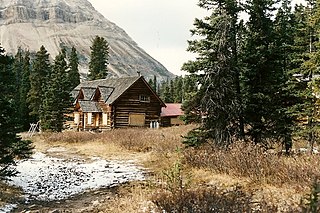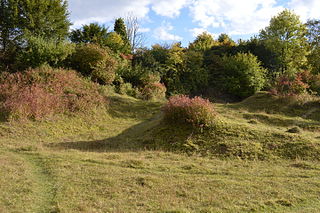
Scotland Yard is the headquarters of the Metropolitan Police, the territorial police force responsible for policing Greater London's 32 boroughs, but not the City of London, the square mile that forms London's historic and primary financial centre. Its name derives from the location of the original Metropolitan Police headquarters at 4 Whitehall Place, which also had an entrance on a street called Great Scotland Yard. The Scotland Yard entrance became the public entrance, and over time "Scotland Yard" has come to be used not only as the name of the headquarters building, but also as a metonym for both the Metropolitan Police Service itself and police officers, especially detectives, who serve in it. The New York Times wrote in 1964 that, just as Wall Street gave its name to New York's financial district, Scotland Yard became the name for police activity in London.

The Northern line is a London Underground line that runs from North London to South London. It is printed in black on the Tube map. The Northern line is unique on the Underground network in having two different routes through central London, two southern branches and two northern branches. Despite its name, it does not serve the northernmost stations on the Underground, though it does serve the southernmost station at Morden, the terminus of one of the two southern branches.

The Grand Canyon of the Yellowstone is the first large canyon on the Yellowstone River downstream from Yellowstone Falls in Yellowstone National Park in Wyoming. The canyon is approximately 24 miles (39 km) long, between 800 and 1,200 ft deep and from .25 to .75 mi wide.
Red Bay is a fishing village in Labrador, notable as one of the most precious underwater archaeological sites in the Americas. Between 1530 and the early 17th century, it was a major Basque whaling area. Several whaling ships, both large galleons and small chalupas, sank there, and their discovery led to the designation of Red Bay in 2013 as a UNESCO World Heritage Site.
Arqiva is a British telecommunications company which provides infrastructure, broadcast transmission and smart meter facilities in the United Kingdom. The company is headquartered at the former Independent Broadcasting Authority headquarters at Crawley Court in the village of Crawley, Hampshire, just outside Winchester. Its main customers are broadcasters and utility companies, and its main asset is a network of circa. 1,500 radio and television transmission sites. It is owned by a consortium of investors led by CPP and the Australian investment house Macquarie Bank. Arqiva is a patron of the Radio Academy.

The Royal Marsden NHS Foundation Trust is an NHS Foundation Trust which operates the Royal Marsden Hospital facilities on two sites:
Babine Lake Marine Provincial Park is a provincial park in British Columbia, Canada. The park was established by Order-in-Council in 1993, comprising two sites at Pendleton Bay totalling 36.9 hectares. Another was established in the same year at Smithers Landing, comprising approximately 157.8 hectares. Three more sites were added in 2001, Hook (Deep) Bay, Pierre Creek, Pinkut Creek and Sandpoint. All sites combined comprise approximately 492 hectares.
Shuswap Lake Marine Provincial Park is a provincial park in British Columbia, Canada, comprising 894 ha. The Park has a variety of amenities including boat launch ramps, picnic areas, and 27 campsites around the perimeter of Shuswap Lake. The lake's name and that of the surrounding Shuswap Country is from the Shuswap people (Secwepemc), the most northern of the Salishan speaking people.

Tytherington Down is a 5.9 hectares biological Site of Special Scientific Interest in Wiltshire, England, notified in 1975. The site spans a dry valley some 1+1⁄2 miles (2.4 km) south of the village of Tytherington and 5 miles (8 km) southeast of Warminster.
Inwood, Warleigh is a 56.9 hectare biological Site of Special Scientific Interest in Wiltshire, notified in 1988.
There are 22 disused railway stations in the 75 miles (121 km) between Bristol Temple Meads and Exeter St Davids, 12 of which have structures that can still be seen from passing trains. Most were closed in the 1960s but four of them, especially around Weston-super-Mare, were replaced by stations on new sites. 13 stations remain open on the line today, but there have been proposals to reopen stations at Cullompton and Wellington.

Horsell Common is a 355-hectare (880-acre) open space in Horsell, near Woking in Surrey. It is owned and managed by the Horsell Common Preservation Society. An area of 152 hectares is a biological Site of Special Scientific Interest and part of the Thames Basin Heaths Special Protection Area.

The National Diving and Activity Centre was a facility located at a large flooded quarry at Tidenham, Gloucestershire, England, near to the border with Wales at Chepstow. It was previously Dayhouse Quarry, a source of limestone, which was flooded in 1996. The diving centre opened in 2003, and closed in 2022.

The Banff Park Museum National Historic Site, located in downtown Banff, Alberta, is an exhibition space associated with Banff National Park. The museum was established in 1895 to house an exhibit of taxidermy mounted specimens of animals, plants and minerals associated with the park. The museum building, constructed in 1903 to the design of territorial government engineer John Stocks, is an early example of the rustic style of architecture that was becoming popular in the parks of North America.

The Skoki Ski Lodge National Historic Site of Canada was built in 1930-31 in the Skoki Valley of Canada's Banff National Park. Built by local members of the Ski Club of the Canadian Rockies, the lodge was the first commercial building built specifically to serve skiers in Canada, and possibly in North America. Design and construction work was carried out by local outfitter and builder Earl Spencer with help from Spud White and Victor Kutschera. The lodge was progressively expanded through 1936 by outfitter, guide and log home builder Jim Boyce who was also managing the Lodge the time. It has remained unaltered since that time. The Lodge operates throughout the year.
Tutshill for Beachley Halt was a request stop on the South Wales Railway and Wye Valley Railway. It was opened on 9 July 1934, and was intended to serve the nearby village of Tutshill. However, though the station was situated a short distance from the junction of the Wye Valley Railway and was still on the main line, the only trains which served the small halt were from the Wye Valley Railway and when the line closed on 5 January 1959, the stop closed with it.
W. H. Dimond was a three-masted barquentine of 390 tons, built by Matthew Turner, of Benicia, California, for J. D. Spreckles for the Island trade. Later transferred to the Oceanic Steamship Co., she was sold out of the trade in 1905, and was converted to a schooner by the Alaska Codfish Co. She was wrecked 17 February 1914, having run aground on Bird Island, Alaska, carrying general cargo from San Francisco to Unga Island. Her lines, sailplan, and a rendering are shown in Chapelle's The History Of American Sailing Ships.

Masons Field is a 2.9 hectare Local Nature Reserve (LNR) in Kingsbury in the London Borough of Brent. It was declared an LNR in 2013, it is owned by London Underground Ltd and managed by Brent Council on a 125-year leasehold.

Aston Clinton Ragpits is a 2.9-hectare (7.2-acre) biological Site of Special Scientific Interest in Aston Clinton in Buckinghamshire. It is a former chalk quarry, which is now a nature reserve managed by the Berkshire, Buckinghamshire and Oxfordshire Wildlife Trust. It is in the Chilterns Area of Outstanding Natural Beauty.










